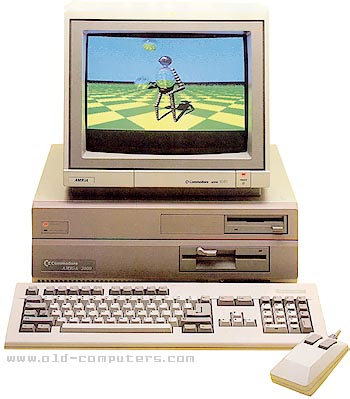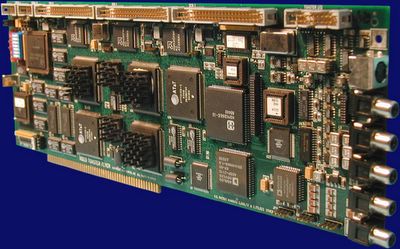
Well, toward the later end of what was a remarkable run in the home computer market, Commodore rolled out the Amiga: maybe the first serious multimedia platform anywhere. There were a few models available for various-sized budgets, but the high-end system was the Amiga 2000. It boasted what was then a whopping 512 K of RAM, which depending on release version it was it could go all the way up to (back in the day anyway) an inconceivably huge 9 MB of memory. The processor speed was 7.14 mHz. And the way the entire system was clocked to run... well, let's just say it lent itself toward some astounding applications.
In 1990, Brad Carvey (brother of Dana Carvey of Saturday Night Live fame, and the inspiration for "Wayne's World" character Garth), Tim Jenison and a few other engineers at a company called NewTek rolled out the Video Toaster. And the Amiga 2000's full capabilities were at last unleashed...

The Amiga 2000, loaded with a Video Toaster, could create a virtually limitless number of titles, graphics, wipes, and other visual elements for real time television production. As a result, hundreds of smaller TV stations (and many visual artists) were able to do with approximately $5000 - the cost of an Amiga and a Video Toaster - what the big network affiliates in town were doing with equipment costing $50,000 and up. Probably the most impressive thing that the Amiga/Video Toaster combo did was rendering the special effects for the pilot movie and first few seasons of the television series Babylon 5, which called into service an entire render farm of networked-together Amigas loaded with Video Toasters.
There's no telling how many Amiga 2000s and Video Toasters wound up being put to work out there. And amazingly enough a few of them - like the setup at our station - are still being used, now almost a decade and a half after acquiring the equipment (the Video Toaster we're using is version 3.1, released in 1993).
NewTek is still making Video Toaster these days, but it's now a plug-in board/software suite for Windows-based machines. No doubt the latest versions are much more robust and slick than the original Amiga versions and certainly faster: it took our system about fifteen seconds to update the dollar amount last night as the pledges came in. But, it still works and gets the job done. And in the end, isn't that the real measure of how good a computer is, no matter how antiquated it may seem? Does it do what it's intended and does it do it fairly well?
In a cyber-driven society that's gone mad with upgrading to the latest model, our station's humble little Amiga 2000 and Video Toaster 3.1 are a nice reminder to me that older technology still has qualities that merit some appreciation. If for no other reason than because they helped pave the way for all the things that we can do with the latest innovations. But it's still nice to know that against the more modern tech, a 20 year old computer and an early Nineties circuit board are still holding their own.








3 comments:
I got a Commodore 64 for Christmas when I was 13. My folks couldn't afford the disk drive, so they bought the peripheral that saved programs onto audio cassettes. One of the reasons I type 40 words a minute even though I hunt-and-peck is because I started writing BASIC programs.
When I was 16 I got a full-time summer job and took all the money I had saved from two paychecks and bought an external disk drive for it. Suddenly, I could play Gunship!
Geek memories...sweet.
My first computer was a Texas Instruments TI-99/4A (I've had a neat story about that in the works for awhile, hope to have it up by summer). Never had the disk drive peripheral but I had the cassette recorder too. It was so much fun to balance the audio levels on it before having the computer "read" the cassette tape. If you listened to it normally it sounded like a lot of static. But I learned to write a little BASIC from this tutorial program that came on tape that we got along with the computer.
I wish that I did have the disk drive though: I wound up with a copy of Tunnels of Doom and it was the floppy version. I've heard so many good things about that game over the years. Someday, somehow, I will play it... somehow :-)
It's refreshing to read about someone who realizes technology is meant to *SOLVE* probmlems, not create more...especially when I helped design the still-useful device (a 20+ year NewTek employee, I started off building Digi-Views!).
Note that with the (almost obscene) speed and capacity of today's computers, most older systems can be emulated in real-time. There are a number of TI-99/4A simulators available that could probably run your game:
http://www.99er.net/emul.html
Charles Steinkuehler
Post a Comment